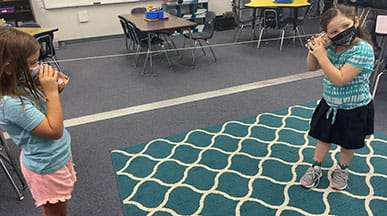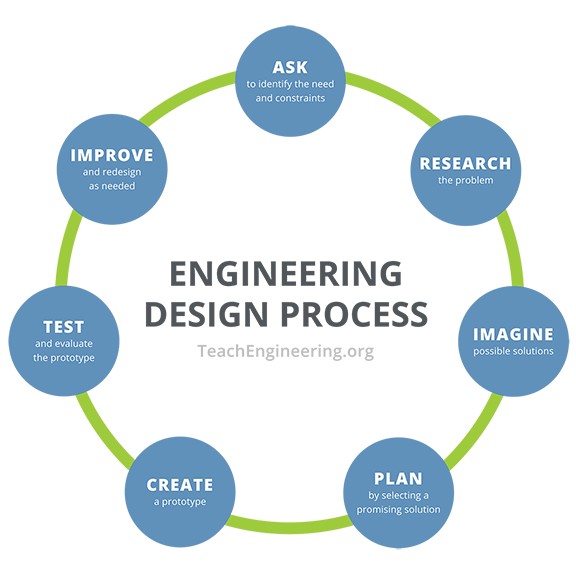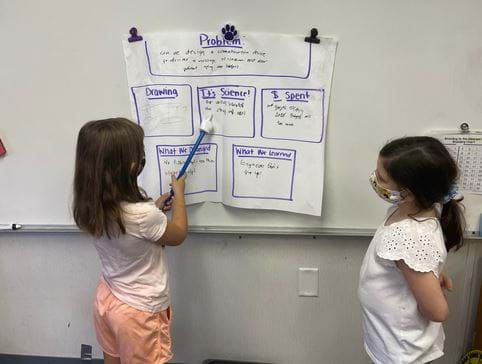Quick Look
Grade Level: 2 (1-3)
Time Required: 3 hours
(time split into three 60-minute class periods)
Expendable Cost/Group: US $5.00
Group Size: 3
Activity Dependency: None
Subject Areas: Physical Science, Problem Solving
NGSS Performance Expectations:

| 1-PS4-1 |
| 1-PS4-4 |
| K-2-ETS1-1 |
Summary
Can you communicate without electricity? In this activity, students explore a problem in which a school’s power has gone out and they need to deliver an important message to a neighboring first grade classroom. However, they must stay within the following constraints: they cannot use cell phones and they have to stay in their classroom while doing so. Students research and use a variety of tools and materials to build, test, and retest a device that communicates sound the most clearly while learning about and demonstrating how sound causes vibrations.
Engineering Connection
Engineers solve problems and discover practical solutions that impact lives. Communication is a vital part of life. Without a telephone, communication is extremely difficult. Students are encouraged to think like engineers using the engineering design process. They investigate and examine variables through design, and conduct background research on various tools and materials. Materials engineers develop, process, and test materials used to create an array of products. They identify needs and constraints, research, imagine possible solutions, choose a solution, and then they create, test, and iterate upon a design to reach an optimal solution.
Learning Objectives
After this activity, students should be able to:
- Identify a communication problem and research possible solutions.
- Use tools and materials to design and build a communication device.
- Think and outline design iteration suggestions.
- Explain and demonstrate that sound can make materials vibrate.
Educational Standards
Each TeachEngineering lesson or activity is correlated to one or more K-12 science,
technology, engineering or math (STEM) educational standards.
All 100,000+ K-12 STEM standards covered in TeachEngineering are collected, maintained and packaged by the Achievement Standards Network (ASN),
a project of D2L (www.achievementstandards.org).
In the ASN, standards are hierarchically structured: first by source; e.g., by state; within source by type; e.g., science or mathematics;
within type by subtype, then by grade, etc.
Each TeachEngineering lesson or activity is correlated to one or more K-12 science, technology, engineering or math (STEM) educational standards.
All 100,000+ K-12 STEM standards covered in TeachEngineering are collected, maintained and packaged by the Achievement Standards Network (ASN), a project of D2L (www.achievementstandards.org).
In the ASN, standards are hierarchically structured: first by source; e.g., by state; within source by type; e.g., science or mathematics; within type by subtype, then by grade, etc.
NGSS: Next Generation Science Standards - Science
| NGSS Performance Expectation | ||
|---|---|---|
|
1-PS4-1. Plan and conduct investigations to provide evidence that vibrating materials can make sound and that sound can make materials vibrate. (Grade 1) Do you agree with this alignment? |
||
| Click to view other curriculum aligned to this Performance Expectation | ||
| This activity focuses on the following Three Dimensional Learning aspects of NGSS: | ||
| Science & Engineering Practices | Disciplinary Core Ideas | Crosscutting Concepts |
| Plan and conduct investigations collaboratively to produce data to serve as the basis for evidence to answer a question. Alignment agreement: Science investigations begin with a question.Alignment agreement: Scientists use different ways to study the world.Alignment agreement: | Sound can make matter vibrate, and vibrating matter can make sound. Alignment agreement: | Simple tests can be designed to gather evidence to support or refute student ideas about causes. Alignment agreement: |
| NGSS Performance Expectation | ||
|---|---|---|
|
1-PS4-4. Use tools and materials to design and build a device that uses light or sound to solve the problem of communicating over a distance. (Grade 1) Do you agree with this alignment? |
||
| Click to view other curriculum aligned to this Performance Expectation | ||
| This activity focuses on the following Three Dimensional Learning aspects of NGSS: | ||
| Science & Engineering Practices | Disciplinary Core Ideas | Crosscutting Concepts |
| Use tools and materials provided to design a device that solves a specific problem. Alignment agreement: | People also use a variety of devices to communicate (send and receive information) over long distances. Alignment agreement: | People depend on various technologies in their lives; human life would be very different without technology. Alignment agreement: |
| NGSS Performance Expectation | ||
|---|---|---|
|
K-2-ETS1-1. Ask questions, make observations, and gather information about a situation people want to change to define a simple problem that can be solved through the development of a new or improved object or tool. (Grades K - 2) Do you agree with this alignment? |
||
| Click to view other curriculum aligned to this Performance Expectation | ||
| This activity focuses on the following Three Dimensional Learning aspects of NGSS: | ||
| Science & Engineering Practices | Disciplinary Core Ideas | Crosscutting Concepts |
| Ask questions based on observations to find more information about the natural and/or designed world(s). Alignment agreement: Define a simple problem that can be solved through the development of a new or improved object or tool.Alignment agreement: | A situation that people want to change or create can be approached as a problem to be solved through engineering. Alignment agreement: Asking questions, making observations, and gathering information are helpful in thinking about problems.Alignment agreement: Before beginning to design a solution, it is important to clearly understand the problem.Alignment agreement: | |
Common Core State Standards - English
-
With guidance and support from adults, recall information from experiences or gather information from provided sources to answer a question.
(Grade
1)
More Details
Do you agree with this alignment?
-
Participate in collaborative conversations with diverse partners about grade 1 topics and texts with peers and adults in small and larger groups
(Grade
1)
More Details
Do you agree with this alignment?
-
Participate in shared research and writing projects (e.g., read a number of books on a single topic to produce a report; record science observations).
(Grade
2)
More Details
Do you agree with this alignment?
Common Core State Standards - Math
-
Use appropriate tools strategically.
(Grades
K -
12)
More Details
Do you agree with this alignment?
International Technology and Engineering Educators Association - Technology
-
Students will develop an understanding of the attributes of design.
(Grades
K -
12)
More Details
Do you agree with this alignment?
-
Students will develop an understanding of engineering design.
(Grades
K -
12)
More Details
Do you agree with this alignment?
-
Students will develop an understanding of the role of troubleshooting, research and development, invention and innovation, and experimentation in problem solving.
(Grades
K -
12)
More Details
Do you agree with this alignment?
Materials List
Each group needs
- computer, laptop or tablet
- Make a Communication Device Worksheet; one per student
- A variety of materials for students to build their devices (Note: give groups unlimited access to each, but they will not be using all materials at once.)
- yarn
- rope
- fishing line
- string
- wire
- a variety of recycled materials that are consumable
- different kinds of tape (Scotch, duct, painters)
- plastic cups
- tin cans of various sizes
- paper cups of various sizes
- plastic cups of various sizes
- toilet paper or paper towel rolls
- meter stick
- scissors
- poster paper
For the entire class to share:
- markers
- nail, hammer, and scissors for teacher
- play money (e.g., Monopoly money) (optional)
Worksheets and Attachments
Visit [www.teachengineering.org/activities/view/uof-2625-designing-communication-device-sound-activity] to print or download.Introduction/Motivation
Who has used a telephone to communicate with someone else? What happens when your phone is not working, and you cannot use it? Has anybody experienced a time where the power and electricity in your home went out? What did not work anymore when that happened? (Have students talk to each other and elicit student responses and discuss between each question.)
We have a problem! We must become engineers to deliver a message to the first-grade class next door. But wait, our class telephone and my cell phone do not work anymore! The batteries are dead, there is no service in here, AND the electricity went out! We must tell the class that school gets out an hour early today! (The teacher can change the important message accordingly.)
What do engineers do? (Elicit student responses and discuss.) Engineers design and build products. The engineering design process has seven steps: Ask, Research, Imagine, Plan, Create, Test, and Improve. For example, engineers brainstormed, designed, built, and tested the materials that our cell phones are made out of to make them not too heavy and easy to carry around.
Today we will act as engineers by designing and creating a device that communicates a message to the classroom next door that they can hear clearly. Like engineers, we will have to work within constraints for our project. We only have certain materials we can use. Each group will have $20 (in play money) to spend on your materials. And finally each group will only have a certain amount of time to design, create and build your devices.

Has anyone ever seen something like this? (Show students a picture of the tin-can as a phenomenon. Example found on The Wonder of Science page for the Tin Can Telephone.) What is going on? How do you think it works? (Discuss with students that it is a communication device.) How can we use this example to brainstorm, design, build and test our devices? Can we use different materials to see if they work better?
Procedure
Background
Sound is a type of energy made up of vibrations. Sound is created when a force causes an object or substance to vibrate. These vibrations called sound waves travel through the surrounding substance (for example, air, water, solid) in a wave to our ears. Stronger vibrations will result in louder sounds; weaker vibrations make softer sounds.
How does a tin-can telephone work? When you speak into the can or cup, your voice creates vibrations that travel into the air and then into the can, vibrate the bottom of the can, which then vibrates the string all the way over to the other can. This vibrates the other can’s bottom, then the air again. Try to feel the vibration of your voice by talking into your hand!
Note: This activity is design to take up time over several class periods (approximately 180 minutes) and can be adapted based on the Procedure below.
Before the Activity
- Gather materials and make copies of the Make a Communication Device Worksheet. (one for each student)
- Cut string and tape to 30 cm to make purchases easier.
- Assign costs to each material and decide how much each group will get. (For example, each group gets $20 to spend on their design and each material costs anywhere from $1.00 - $3.00.)
- Display the materials and costs to students in a common area. Example of costs:
- $1 per 30 cm of string
- $1 per cup
- $2 per 30-cm of tape
With the Students
- Divide the class into groups of three students.
- Explain the problem the students are trying to solve.
- Hand out the Make a Communication Device Worksheet.
- Provide students with the following constraints:
- Each group has a $20 budget that cannot be exceeded.
- Each group’s device must be at least 6 meters long.
- Have students write down, in their own words, what the problem is that they are trying to solve on their Make a Communication Device Worksheet.
- Explain to students that they are diving into the second step of the engineering design process: research. (Engineers research what products or solutions already exist, and/or what technologies might be adaptable to their product.) Either at the library or with computers/laptop/tablet, allow students to research what materials would make a good communication device and allow sound to flow through freely—engineers research the problem and existing solutions to come up with new ideas and solutions. Have them take notes on their Make a Communication Device Worksheet.
- Give students time to brainstorm what materials they would like to try first to build their communication device. Remind students that they have a budget of $20—engineers often work with time, size, and financial constraints!
- Their notes should be included on their Make a Communication Device Worksheet. Remind them to think about the research they did about what materials allow sound to flow through freely.
- After brainstorming ideas, each group selects their most promising solution and which materials they want to use. They should sketch their agreed upon design in their Make a Communication Device Worksheet. At the same time, they should decide what materials they would like to purchase, how much they are, and add the costs for a final cost.
- Once the budget is checked by a teacher, have one student from each group take the materials they need from the materials display.
- Give students time to build their devices with their chosen materials.
- Guide students to create, test, and evaluate their devices. To test their device, have students measure out 6 meters with a meter stick and speak into their device to each other. Ask them clarifying and probing questions such as:
- “Can you hear the other person?”
- “Is it loud or too quiet?”
- “How can we make it louder?”
- “Can you hear and feel the vibration of your voice through the device?”

- Make sure to circulate the room and help groups speak into their devices if needed. Have students determine what worked and what didn’t in their design. Remind students that they should learn from their failures and encourage them to use new materials to alter their designs and record what materials they will want for their next design iteration on their worksheets. (Note: Engineers are constantly iterating and improving their designs based off their testing and feedback to develop a better product.)
- Have the groups iterate on their design based on their observations of how clear the sound is (number of iterations is at the teacher’s discretion). Each time they change their designs, they may come up to the material area, and receive an extra $3.
- After groups have had time to design multiple iterations, have them compare their designs to other groups, including measuring their devices with and without meter sticks.
- Give each group one piece of poster paper and markers to present their design process. Students should include the following on their poster
- Problem: can we design a communication device to deliver a message to the classroom next door without going over budget?
- Drawing of their final design.
- Science behind the challenge: did the sound of your voice vibrate any part of your design?
- What they changed in each design phase.
- What they learned from failed tests of certain materials and designs.
- How much money they spent and why budgeting matters in engineering.

Vocabulary/Definitions
communication: Sharing or exchange of messages, information, or ideas.
device: A thing made for a specific purpose.
engineer: One who is trained in the use or design of machines or engines, or in other technologies.
sound: Anything that people or animals can hear with their ears.
Assessment
Pre-Activity Assessment
Quick Poll: Before the activity begins, ask students what materials they think will act as the best communication device. If time allows, ask them to justify their answers.
Activity Embedded (Formative) Assessment
Worksheet: Have students either work individually or with their group to complete the Make a Communication Device Worksheet.
Post-Activity (Summative) Assessment
Presentation: Each group will present their devices and findings to the class as a poster or digital presentation. Teachers can use the Teacher Presentation Rubric for assessment.
Discuss/think-pair-share: What causes the vibration in your devices? (Answer: the sound from your voice) How did you act as engineers today? (Example answer: we identified a problem, then we researched, brainstormed and planned how to solve that problem. Next, we designed and built a device for someone to use. We tested and evaluated our device, and we recorded our observations, etc.)
Activity Extensions
- Using Google Slides, have students create their presentation in a digital format.
- Read the book Sounds All Around: The Science of How Sound Works to learn more about sound and vibrations.
Activity Scaling
- For lower grades:
- Remove the budget constraint.
- Conduct research as a class.
- Set up student posters ahead of time so that students only have to write in the details.
- For upper grades:
- Make each material a specific amount of money to match grade level math standards. For example, changing $3 to $3.08.
- Have students create their own poster presentation from scratch instead of giving them a template.
Subscribe
Get the inside scoop on all things TeachEngineering such as new site features, curriculum updates, video releases, and more by signing up for our newsletter!References
Andersen, Paul. “Tin Can Telephone.” The Wonder of Science, The Wonder of Science, 16 July 2018, thewonderofscience.com/phenomenon/2018/5/3/tin-can-telephone. Accessed 10/28/2021.
Copyright
© 2021 by Regents of the University of Colorado; original © 2021 University of FloridaContributors
Kayla SutcliffeSupporting Program
Multidisciplinary Research Experiences for Teachers of Elementary Grades, Herbert Wertheim College of Engineering, University of FloridaAcknowledgements
This curriculum was based upon work supported by the National Science Foundation under RET grant no. EEC 1711543— Engineering for Biology: Multidisciplinary Research Experiences for Teachers in Elementary Grades (MRET) through the College of Engineering at the University of Florida. Any opinions, findings, and conclusions or recommendations expressed in this material are those of the authors and do not necessarily reflect the views of the National Science Foundation.
Last modified: February 13, 2023






User Comments & Tips